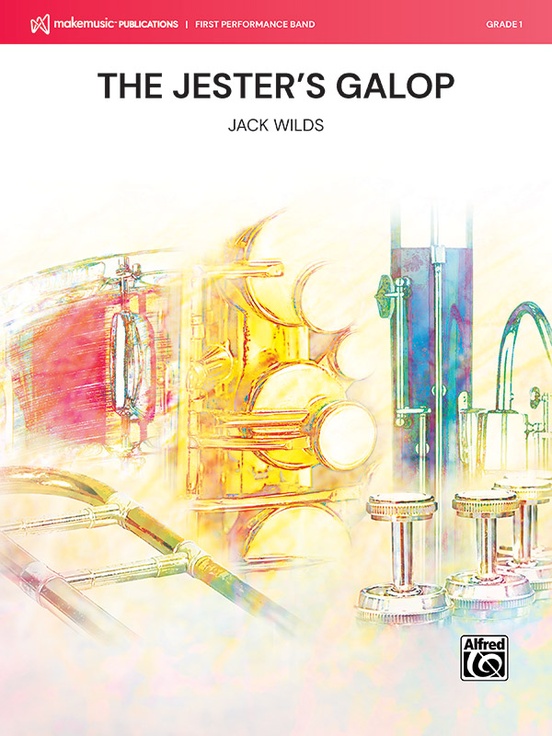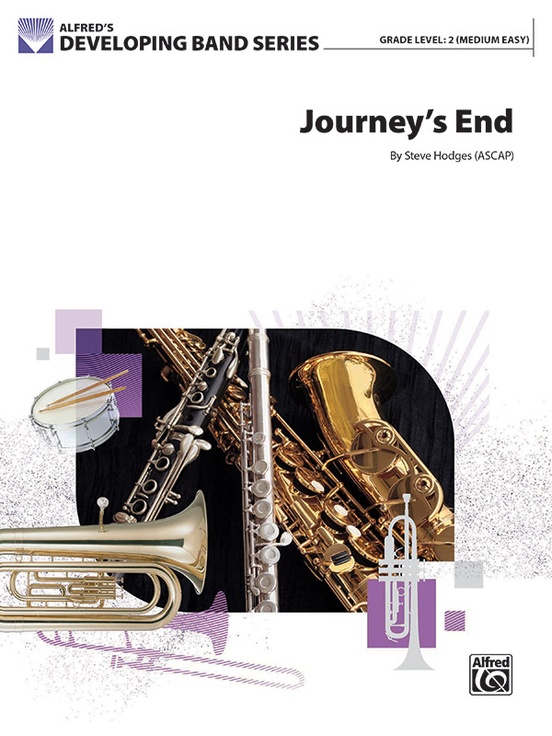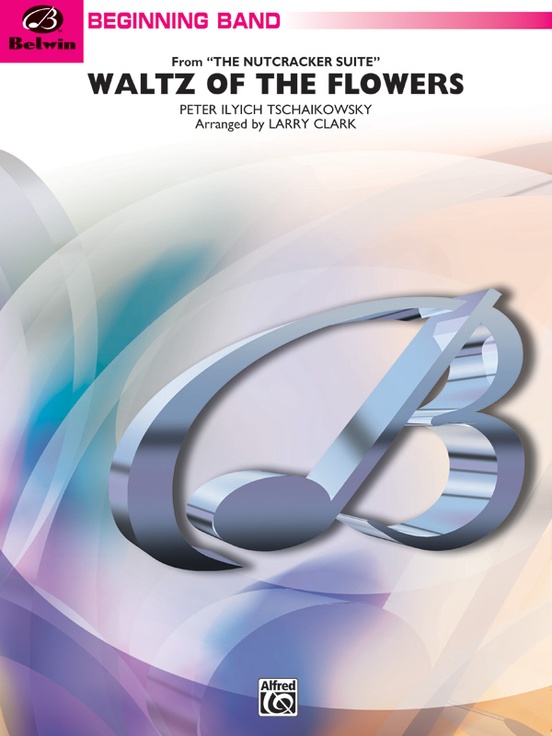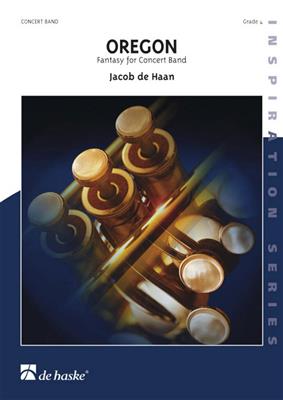Results
-
 £41.58
£41.58Santa's Holiday Favorites (Concert Band - Score and Parts) - Swearingen, James
The holiday season comes alive with this rousing rendition of three seasonal favorites: "Jingle Bells," "Deck The Halls," and "Up On The Housetop." Each selection has been crafted in a very creative way. You should be aware that the musical energy, from beginning to end, will leave your audience breathless and certainly wanting for more. A real showstopper!
Estimated dispatch 7-14 working days
-
 £43.56
£43.56The Soaring Spirit (Concert Band - Score and Parts)
Celebrating the enduring human spirit, composer Rob Grice has created this exciting concert/festival work for the young band. "The Soaring Spirit" is musical energy, grace and elegance from the beginning to end. Solid teaching material and scoring in a very musical setting make this an excellent programming choice for any concert performance.
Estimated dispatch 7-14 working days
-
 £50.50
£50.50The Jester's Galop - Jack Wilds
Dramatic and full of humor, will showcase your ensemble in a musical whirlwind from beginning to end. Complex sounding yet extremely playable, the work allows for a lot of musical exploration with opportunities to work on dynamic contrast, fermatas, cesuras, and style to heighten the excitement. A phenomenal work by Jack Wilds! (1:50)
Estimated dispatch 3-5 working days
-
 £50.50
£50.50The Last Gladiator - Timothy Loest
Experience the brutal energy of the Roman Colosseum in this larger-than-life work by Timothy Loest. Heart-pounding drums and sword-clashing sound effects tell the heroic story of St. Telemachus, a frail monk whose bravery brought the gladiatorial games to an end. Exhilarating and epic, will absolutely be a student and audience favorite! (1:00)
Estimated dispatch 3-5 working days
-
 £52.95
£52.95Journey's End - Steve Hodges
Upon completion of an activity, an event, or other meaningful experiences, there is a time for reflection for what has been accomplished and what is to follow. This lyrical piece features a memorable melody that is presented by all sections of the band. These reflective presentations lead into a slightly faster minor section indicating the anticipation of plans for the future. The final presentation of the melody indicates a positive feeling of accomplishment and features a moving countermelody by the woodwinds leading to a quiet, contemplative ending. Check out , composed by Steve Hodges. (2:48) This title is available in MakeMusic Cloud.
Estimated dispatch 3-5 working days
-
 £53.95
£53.95Waltz of the Flowers (from ) - Peter Ilyich Tchaikovsky / arr. Larry Clark
From Tchaikovsky's ballet comes this fresh scoring for young band or wind ensemble. The technical demands have been reduced, but the musical content is strongly in evidence. With a charming flow from beginning to end, this work will find its way into thousands of holiday concerts and programs at other times of the year. Delightful! (duration 1:27)
Estimated dispatch 3-5 working days
-
 £183.99
£183.99Five States of Change - Philip Sparke
Five States of Change was commissioned by Kunstfactor for the 4th section of the Dutch National Brass Band Championships (NBK) 2011. It is dedicated to Jappie Dijkstra and the Music Information Centre (MUI), Arnhem, Holland, in acknowledgement of their outstanding work in developing band repertoire.The composer writes: "The idea for the piece came when I was reading an article about a branch of Chinese philosophy which is abbreviated as Wu Xing*, which has no exact translation but can mean, for example, five elements, five phases or five states of change. It is central to all elements of Chinese thought, including science, philosophy, medicine andastrology, and in simple terms tries to create various cyclic relationships between five elements in all walks of life.An example is: Earth - Metal - Water - Wood - Fire - (Earth) etc. where (in one cycle) earth bears metal, metal changes to liquid (water) when heated, water helps trees grow, wood burns to create fire, fire produces ash (earth) and the cycle continues.I was particularly interested in the cycle of emotions:- Meditation - Sorrow - Fear - Anger - Joy - (Meditation) etc. and thought this cyclic principle would provide an effective emotional journey for a piece of music. So Five States of Change has five equal sections which loosely characterise this emotional cycle. I have tried to make the music grow organically, with minimal repetition, and each movement evolves from the musical elements at the end of the previous one, with the opening material appearing, transformed, at the end of the piece to complete the cycle. *in full Wu zhong liu xing zhi chi or the five types of chi dominating at different times
Estimated dispatch 7-14 working days
-
£109.99
Dublimania - Menno Bosgra
This new work is based on Irish folk music.In the first part, the main theme is presented as a ballad, starting with the piccolo (as replacement for the flute which is widely used in Ireland), moving on the wood section to end with the entire orchestra.It then changes to a kind of rock style theme: powerful, rhythmic accompaniment with effects in dampers, a pedal point and the use of the spoons which is typical of Irish music (Irish pub), high-range bongo drum (replacement for the Bodhran), etc.In this second part I introduced a second theme as a counterbalance, played by several groups, which has clearly a more legato character and therefore sounds more melodious.The climaxof the work starts in the low-range brass section with its marcato theme that is developed with a great deal of rhythmicity in the accompaniment, clusters, etc. into a percussion solo interspersed by the orchestra in five-eight time with frequent parallel movement in chords (folk music style).Towards the end, theme 2 recurs twice: first as heard earlier with an extra counter melody and accompaniment pattern, then in a canonical form, in which the theme is played by three groups. The conclusion is a repeat of the middle section in five-eight time.I have tried to use many of the colours of a wind orchestra by having the wood sections and brass section play alone and making extensive use of dampers. Percussion also has a prominent role throughout the work.
Estimated dispatch 7-14 working days
-
 £137.99
£137.99Oregon - Jacob de Haan
This fantasy tells the story of Oregon, one of America's north-western states. Traveling by train on the Northern Pacific Railroad, the listener is taken through the fascinating Oregon landscape. Indians, cowboys, golddiggers and hooded wagons will file past on this adventurous journey. The piece has some similarities with a soundtrack of a movie. Various melodies, which could be the main themes of a movie, pass the review.The piece begins in a slow movement, introducing the first theme in minor. Then we hear in the following fast movement the trombones imitate the train, whistling the steam-flute. We hear the characteristic minor theme again, but now in different variants(also in major). The rythmic structure of "western" stile and rock succeed each other. This is leading to the slow movement, where the signals of horns and trumpets introduce a wonderful vocal melody. After this characteristic melody, the fast movement appears shortly again, the trombones whistling the steam-flute again (now in major). We hear also some musical elements, that plays a part in the following Presto. Barchanges, jazzy chords, interesting rhytmic patterns (with bongo) and an original theme are the characteristics of this Presto. After this, the horns announce the last section of the piece. Interesting is the fact that we hear in this Allegro section a variant of the vocal melody in the slow movement. Also the Presto theme returns shortly, followed by the Allargando, which is a grand characteristic end of a soundtrack. The movie of our travelling fantasy has come to an end.
Estimated dispatch 7-14 working days
-
 £69.99
£69.99Cowboy Suite - Alan Laken
In the tripartite 'Cowboy Suite' Alan Laken takes us to the Wild West, the domain of cowboys, indians, trappers and other fortune hunters. Around 1890 the west coast of America was reached, which in effect meant the end of the Wild West. Its stories, however, survived and have been a source of inspiration for many books, films, and, of course, music. Some characters, such as Jesse James, Billy the Kid, and Buffalo Bill are forever linked to these tales. In the 'Cowboy Suite' we first hear the 'Hoedown'. At the end of an exhausting workday the labourers used to lay down their tools, among others the 'hoes' and spontaneously began to play music on the instruments which they then possessed (guitars, fiddles, and banjos) and to dance. After being jolted on the 'Wagon Trail' we reach the third part, the 'Cowboy Roundup'. In this last part it becomes clear that as a cattle driver it is imperative to stay firmly seated in the saddle. As the cattle are rounded up, i.e. driven together, spectacular things happen.
Estimated dispatch 7-14 working days
